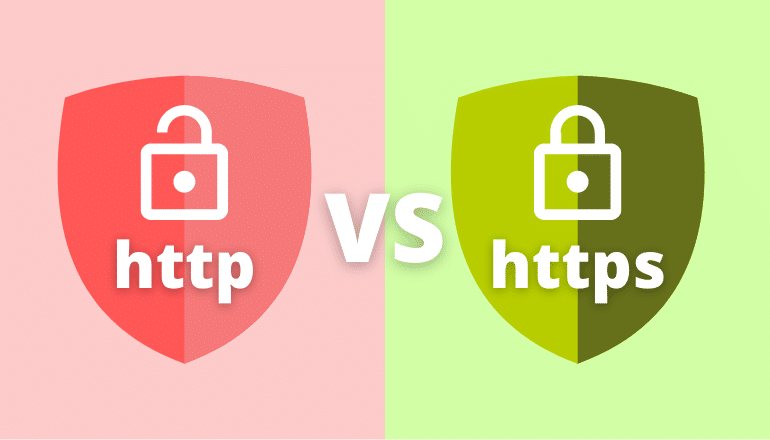HTTP vs. HTTPS: Starting from scratch
While browsing the internet, you’ve probably seen that some websites are marked as “not secure”. And if you took a closer look, you might have noticed that the URLs for those sites begin with http://, while others begin with https://.
What’s the difference between HTTP and HTTPS, and why should you care? Let’s take a look at the difference between both protocols and why HTTPS is a better option for most use cases.
Before we dive into the nuances of HTTP vs. HTTPS, let’s first get a general understanding of what these protocols are and how they work.
What is HTTP?
HTTP stands for Hypertext Transfer Protocol and is the standard application layer network protocol used for communication and data transfer between browsers and web servers on the internet. An HTTP request is generated by user interactions on a web browser and sent to a web server, which generates an HTTP response and sends it back to the user.
HTTP requests and responses are sent over the internet in plain text format. As a result, anyone monitoring the connection can easily read the encrypted data in those messages. So is HTTP secure? It’s safer to say no. Thus, HTTP protocol is not ideal for use cases where users must send sensitive data such as passwords or bank details over the internet.
What is HTTPS?
So what does HTTPS mean? HTTPS stands for Hypertext Transfer Protocol Secure and is an extension of HTTP protocol that uses the Transport Layer Security (or Secure Sockets Layer) protocol to establish an encrypted connection between a server and a web browser. As a result, HTTPS protocol is sometimes referred to as HTTP over TLS or HTTP over SSL protocol. Basically, it is a secure version of HTTP.
When HTTPS is used, the HTTP requests and responses are encrypted, making it impossible for an attacker or eavesdropper to access any sensitive information contained within them.
Table of Contents
What is the main difference between HTTP and HTTPS?
Encryption and authentication
HTTP traffic is not encrypted and susceptible to eavesdropping and man-in-the-middle attacks. HTTPS, on the other hand, uses the TLS (or SSL) security protocol to create a secure connection and only transmits encrypted data over the network. This method of encrypting data involves using a public key and a private key to generate a short-term session key that is then used to encrypt the data transfer between the client and the server.
In public-key encryption, the owner of a private key can encrypt data which anyone can then decrypt with the public key. Also, anyone with the public key can verify that any data received from the private key owner is from an authentic source.
TLS/SSL certificate
In HTTPS, the public key is stored in a website’s TLS/SSL certificate. These certificates are issued and signed with a private key by a Certificate Authority (CA), any trusted third-party organization that gives SSL certificates. Every web browser has a list of trusted CAs, and most browsers alert users when they receive invalid security certificates.
During a TLS/SSL handshake, public-key encryption is used to authenticate the origin server’s public-key identity and the digital signature on the SSL certificate. Once this process is completed, the client and the server will generate session keys for secure symmetric encryption.
Data security
All subsequent communication between the server and the client is then encrypted with the session keys. So if anyone intercepts the HTTPS requests and responses, they’ll only see the ciphertext and not any sensitive information. HTTPS also helps protect against malicious activity such as on-path attacks, DNS hijacking, BGP hijacking, and domain spoofing. Therefore, HTTPS is a more secure protocol.
Which is better and safer, HTTP or HTTPS?
As we have already discussed, when it comes to data security, HTTPS is undoubtedly the safer option. In fact, according to the PCI Data Security Standard, using HTTPS instead of HTTP is a requirement for websites that collect and process payment information.
Internet users are getting more aware of the importance of entering sensitive data only on websites that use the HTTPS protocol. For example, since July 2018, Google Chrome and other browsers have begun to flag HTTP sites without valid SSL certificates as “not secure” in the URL bar. Thus, it’s become necessary for businesses to implement HTTPS on their websites to build trust with visitors and avoid a negative impact on their brand.
In its bid to encourage the switch to HTTPS, Google began using HTTPS as a ranking signal in 2014. As a result, using HTTPS is now a vital part of any effective SEO strategy. In addition, HTTPS is also essential for creating Accelerated Mobile Pages (AMP), which can boost rankings on mobile devices.
Modern browsers now also limit functionality for unsecured HTTP sites. For example, features such as geolocation, push notifications, and advanced web applications (PWAs) require HTTPS to function correctly.
Even concerns such as cost and performance, which may have deterred some from switching to HTTPS in the past, are no longer significant issues. Thanks to the adoption of HTTP/2, which decreases latency and improves page loading speed, switching over to HTTPS now results in performance improvements. Also, it is now possible to get domain validation TLS/SSL certificates for free from organizations such as Lets Encrypt, Cloudflare, and Amazon.
Conclusion
HTTPS adoption has been on the rise in recent years, and it’s already become the standard protocol on the internet. Hopefully, this article helped you understand the difference between HTTP and HTTPS and the need to move over to HTTPS.
- Tags:
- https




